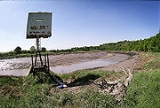
Horseshoe Bend, Shirehampton
Encyclopedia
Horseshoe Bend, Shirehampton is a 4.45 hectare
biological Site of Special Scientific Interest in Bristol
, England, on the north bank of a lower, tidal stretch of the River Avon
, 3 kilometres downstream from the Avon Gorge
, and just east of the village of Shirehampton
. It was notified as an SSSI in 1999.
. The underlying rocks are Devonian sandstone
and Carboniferous limestone
, overlain by with Triassic
Dolomitic conglomerate
.
here are the whitebeams Sorbus eminens
and Sorbus anglica
, both of which are also nationally rare in Britain. The nationally scarce Large-leaved Lime (Tilia platyphyllos) also occurs, and herbs include Field Garlic
(Allium oleraceum) and Pale St. John's-wort (Hypericum montanum).
Hectare
The hectare is a metric unit of area defined as 10,000 square metres , and primarily used in the measurement of land. In 1795, when the metric system was introduced, the are was defined as being 100 square metres and the hectare was thus 100 ares or 1/100 km2...
biological Site of Special Scientific Interest in Bristol
Bristol
Bristol is a city, unitary authority area and ceremonial county in South West England, with an estimated population of 433,100 for the unitary authority in 2009, and a surrounding Larger Urban Zone with an estimated 1,070,000 residents in 2007...
, England, on the north bank of a lower, tidal stretch of the River Avon
River Avon, Bristol
The River Avon is an English river in the south west of the country. To distinguish it from a number of other River Avons in Britain, this river is often also known as the Lower Avon or Bristol Avon...
, 3 kilometres downstream from the Avon Gorge
Avon Gorge
The Avon Gorge is a 1.5-mile long gorge on the River Avon in Bristol, England. The gorge runs south to north through a limestone ridge west of Bristol city centre, and about 3 miles from the mouth of the river at Avonmouth. The gorge forms the boundary between the unitary authorities of...
, and just east of the village of Shirehampton
Shirehampton
Shirehampton, near Avonmouth, at the north-western edge of the city of Bristol, England, is a district of Bristol which originated as a separate village. It retains something of its village feel, having a short identifiable High Street with the parish church situated among shops, and is still...
. It was notified as an SSSI in 1999.
Site Description
The site consists of a wooded cliff and a narrow salt marshSalt marsh
A salt marsh is an environment in the upper coastal intertidal zone between land and salt water or brackish water, it is dominated by dense stands of halophytic plants such as herbs, grasses, or low shrubs. These plants are terrestrial in origin and are essential to the stability of the salt marsh...
. The underlying rocks are Devonian sandstone
Old Red Sandstone
The Old Red Sandstone is a British rock formation of considerable importance to early paleontology. For convenience the short version of the term, 'ORS' is often used in literature on the subject.-Sedimentology:...
and Carboniferous limestone
Carboniferous limestone
Carboniferous Limestone is a term used to describe a variety of different types of limestone occurring widely across Great Britain and Ireland which were deposited during the Dinantian epoch of the Carboniferous period. They were formed between 363 and 325 million years ago...
, overlain by with Triassic
Triassic
The Triassic is a geologic period and system that extends from about 250 to 200 Mya . As the first period of the Mesozoic Era, the Triassic follows the Permian and is followed by the Jurassic. Both the start and end of the Triassic are marked by major extinction events...
Dolomitic conglomerate
Conglomerate (geology)
A conglomerate is a rock consisting of individual clasts within a finer-grained matrix that have become cemented together. Conglomerates are sedimentary rocks consisting of rounded fragments and are thus differentiated from breccias, which consist of angular clasts...
.
Wooded cliff
The site's principal interest and the reason for its designation as an SSSI is the presence of a population of the True Service-tree (Sorbus domestica) growing on the cliffs. This tree is nationally rare in Britain, and this site hosts the largest known population in England. Other notable species of SorbusSorbus
Sorbus is a genus of about 100–200 species of trees and shrubs in the subfamily Maloideae of the Rose family Rosaceae. Species of Sorbus are commonly known as whitebeam, rowan, service tree, and mountain ash...
here are the whitebeams Sorbus eminens
Sorbus eminens
Sorbus eminens, sometimes classified as Aria eminens when the Aria subgenus of Sorbus is elevated to full genus, is a species of plant in the Rosaceae family. It is endemic to the United Kingdom. It is threatened by habitat loss.-Source:...
and Sorbus anglica
Sorbus anglica
Sorbus anglica, the English whitebeam is a species of tree in the Rosaceae family. It is uncommonly found in Ireland and the United Kingdom, with an entire British population estimated at about 600. individuals.-Source:...
, both of which are also nationally rare in Britain. The nationally scarce Large-leaved Lime (Tilia platyphyllos) also occurs, and herbs include Field Garlic
Field garlic
Field garlic is a bulbous perennial that grows wild in dry places in northern Europe, reaching 80cm in height. It reproduces by seed, bulbs and by the production of small bulblets in the flower head . Unlike A. vineale however, it is very rare with Field garlic to find flower-heads containing...
(Allium oleraceum) and Pale St. John's-wort (Hypericum montanum).
Saltmarsh plants
The saltmarsh vegetation, which lies at the base of the cliff, is predominantly made up of Sea Aster (Aster tripolium) and English Scurvygrass (Cochlearia anglica). There are however two nationally scarce vascular plant species here as well - Slender Hare's-ear (Bupleurum tenuissimum) and Long-stalked Orache (Atriplex longipes).External links
- English Nature (SSSI information)
- Aerial photo at Windows Live Local

